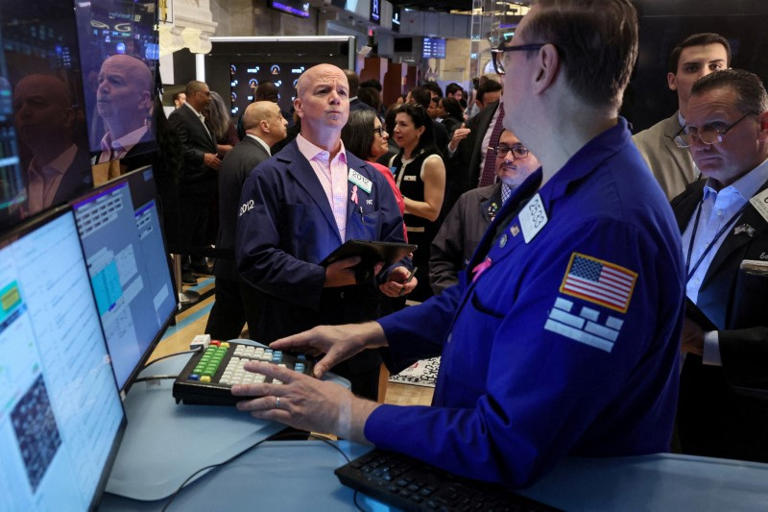Panic in U.S. stock markets seems to have diminished following last week’s dramatic rise in volatility, yet historical patterns suggest that markets might remain unsettled for some time. The Cboe Volatility Index (VIX), a key measure of investor anxiety, experienced a sharp decline after peaking at a four-year high last week. As of the latest reports, the VIX has retreated to around 20, significantly lower than its recent peak of 38.57 on August 5. This drop reflects a reduction in immediate market fear, even as the S&P 500 has rebounded by approximately 3% from its recent lows, signaling a partial recovery from what was described as the most severe market plunge of the year.
The rapid easing of the VIX has been interpreted by some market observers as indicative of a correction driven largely by the unwinding of substantial leveraged positions. These include yen-funded carry trades, where investors borrow at low interest rates in yen to invest in higher-yielding assets such as U.S. technology stocks and cryptocurrencies. This interpretation suggests that the recent volatility may have been more about specific trading strategies than about broader economic or growth concerns.
However, historical data shows that markets often remain volatile for extended periods following significant spikes in the VIX. The index typically takes an average of 170 trading sessions to revert to its long-term median level of 17.6 after surpassing the 35 mark, a level associated with heightened investor anxiety. This historical trend implies that while the VIX has decreased, the market may continue to experience elevated volatility and investor caution in the coming months.
JJ Kinahan, CEO of IG North America and president of online broker Tastytrade, emphasized that once the VIX stabilizes within a more typical range, investor behavior may shift towards a more passive stance. Nevertheless, he cautioned that the aftermath of such volatility spikes often results in a period of market unease lasting between six to nine months. This period may discourage aggressive risk-taking, which had previously fueled asset price increases.
The recent volatility comes on the heels of a notably strong period for U.S. stocks. The S&P 500 had surged nearly 19% through early July, reaching all-time highs. However, this upward momentum was interrupted by a series of events that spurred a broad market sell-off. Disappointing earnings reports from several highly valued technology companies led to a significant decline in stock prices and a surge in the VIX.
Further complicating the market dynamics, the Bank of Japan’s unexpected decision to raise interest rates by 25 basis points in late July had significant repercussions. This rate hike disrupted global financial markets, particularly impacting carry trades that involved borrowing cheaply in yen to invest in higher-yielding assets. The tightening of these trades, combined with a series of alarming economic data from the U.S., contributed to an 8.5% drop in the S&P 500 from its July highs, approaching the 10% correction threshold. Despite this decline, the index remains up about 12% for the year, reflecting overall positive market performance despite recent turbulence.
Mandy Xu, head of derivatives market intelligence at Cboe Global Markets, noted that the market’s rapid decline and subsequent rebound were largely driven by specific equity and foreign exchange market movements, with less impact observed in other asset classes like interest rates and credit markets. This suggests that the volatility was more a reflection of investor positioning and less indicative of systemic issues across various asset classes.
Looking forward, investors are closely monitoring upcoming U.S. economic data, including the consumer price index (CPI) report scheduled for August 14. This data will be crucial in determining whether the recent economic slowdown is a temporary phenomenon or indicative of a more serious economic downturn. Additionally, political uncertainties, such as the upcoming U.S. presidential election and potential geopolitical tensions in the Middle East, are contributing to ongoing market apprehensions.
Nicholas Colas, co-founder of DataTrek Research, advises that the market’s stability will be better assessed once the VIX remains consistently below its long-term average of 19.5. Until the VIX falls below this level for an extended period, Colas recommends a cautious approach, avoiding attempts to time market bottoms or select individual stocks prematurely.
Another point of concern is the market’s near miss of correction territory. Historical data indicates that when the S&P 500 approaches a correction—defined as a decline of 10% from a recent high—there is a strong tendency for the index to eventually confirm a correction. Of the 28 instances where the index came within 1.5% of a correction, it confirmed one in 20 cases within an average of 26 trading sessions. Conversely, in the eight instances where a correction was not confirmed, it took an average of 61 trading sessions for the index to reach a new high.
The upcoming CPI data, along with earnings reports from major retailers such as Walmart, will be pivotal in shaping investor sentiment and market dynamics. Mark Hackett, chief of investment research at Nationwide, highlights that investors should be prepared for potentially exaggerated market reactions to this data, given the heightened emotional state of the market recently.
In summary, while the immediate panic in U.S. stock markets appears to have eased, historical patterns suggest that volatility and uncertainty may persist. Investors should remain vigilant and cautious, considering both the historical tendencies of market behavior following volatility spikes and the upcoming economic and political developments that could influence market conditions.
